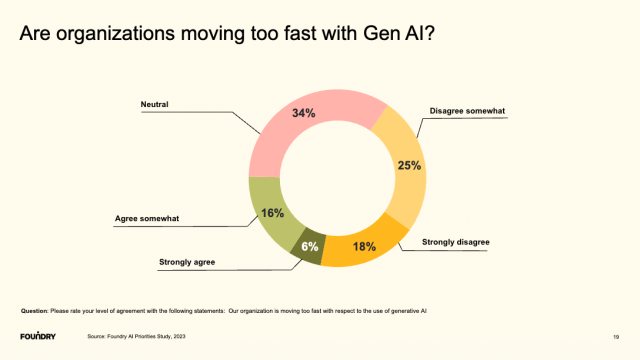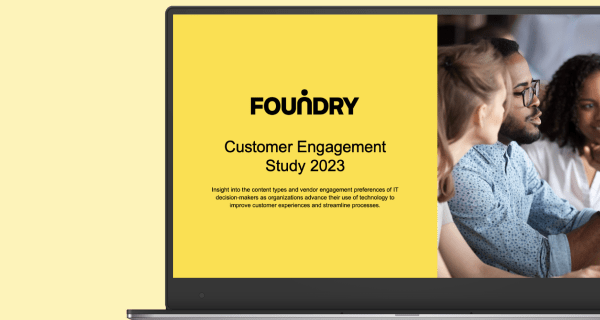So you have to whip up a piece of quality content by the end of the day. You’ve got the data, the target audience, the points you want to make. Now it’s time to write it up. But that’s the problem, there is no time.
Not to worry! Plug a prompt into the AI chatbot of your choice and badabing badaboom, you’ve got content. But after you trim the fat, the forced synonyms for ‘engaging’, and everything extrapolated beyond your prompt, you have… something that sounds pretty generic. Wasn’t AI supposed to make this effortless and innovative?
The AI disconnect
When it comes to content creation and copy writing, it’s hard not to depend on the seemingly productive use of Generative AI. I would be lying if I said I wasn’t tempted to use it myself for this very blog. But instead, I pried into whether the benefits of using Gen AI as a tech marketer do outweigh the often-overlooked negatives.
According to Foundry’s latest AI Priorities Study, content generation is the second most popular use case for Gen AI and yet nearly 1/4 of IT decision-makers are concerned that their organization is moving too fast to adopt this new tech, creating a glaring disconnect between the 54% of ITDMs using AI to boost productivity, and the looming concern about its implications.
I fear that our growing dependency on Gen AI is leading to a decline in originality, linguistic style and humour in marketing efforts. Yes, you can input tonal suggestions into prompts (my go-to is Spartan), but its amalgamating algorithm strips copy of authentic personality. It could be argued that this is for the best – that B2B techmarketing should steer away from the individualism of ‘human’ linguistic style to focus on communicating success and trust with clarity. We expect B2B tech content to provide facts and insight, not puns on intent data creating a surge of interest. I’ve experienced firsthand when A/B testing that more risky/cheeky/original subject lines don’t necessarily get higher open rates than straightforward subject lines, usually including a fact or stat. Is this indicative of our expectations or stringent guidelines for tech marketing copy? Does B2B tech marketing have to be devoid of personality for the sake of trustworthiness and communicating credibility?
Finding a balance: B2C copy vs. B2B
B2C copy seems to always be having more fun than B2B, striving to sound as human as possible. Ads on the London Underground are essentially an extended joke reel, written by marketers trying to convince commuters that their brands are relatable and not profit-driven. I find that most of these campaigns are trying too hard to evoke an emotional response, to the point they turn into Uncanny Valley caricatures of their target audience.
What’s interesting is the growing presence of B2B brands following suit, for multiple reasons. Some may be trying to stand out from their corporate competitors and position themselves as young, hip, innovative organizations that are in on the trends. Or, it may be to intentionally target younger people, now that Gen Z and Millennial IT decision-makers are important gatekeepers in the buying team. B2B campaigns could also be trying to humanize their voice in the social media space, to contribute their own dose of dopamine to feeds intended for entertainment and individual consumption. It may be a combination of these factors, but if this trend persists, B2B copy could take a turn (for better or for worse) very quickly.
All organizations have values that inform their corporate tone, from language choices to design elements and beyond. But when their marketers are trying to take up space across channels, especially on social which is inherently individualistic, it’s important to show your audience that the organization is not an individual but made up of individuals. Well-executed leadership blogs, podcasts, interviews, and expert takeaways from research hit the right balance of personable and credible. These content types show how your organization is made up of experts who want to share their insights with peers and prospects to better the field. Recently we launched our first ‘Stories Inspire. Data Connects.’ campaign to champion the expertise within our organization to educate and inspire tech marketers. The content is created by humans in their own authentic voice, rather than editing away the personality that we, and our audience love about them. At the end of the day, how can a brand convey who they are without the people they’re made up of? Or build trust and familiarity by trying to ‘sound human’ while simultaneously stripping away the quirks, emotions, that help audiences really connect and resonate with them.
So, how should we be using Gen AI in content creation?
Firstly, content should prioritize giving your prospects what they want, and not just what you want prospects to know about you. Substance over style, in other words. What I find most useful about Gen AI is not the ease of content creation, but how it can make content more clear and concise. By using chatbots like ChatGPT and Bard to cut down copy to a certain word count and summarise key points, you can check if its takeaways align with your intentions. Using Gen AI to optimize rather than create will ultimately preserve creative autonomy as marketers. There’s no need to be afraid that ChatGPT will be replacing marketers when we are best informed to tailor our content to tech buyers and what they’d find most useful in their buyer’s journey.
This blog was 100% written by a human, for better or for worse. I urge you to reconsider your use of Gen AI in the name of productivity. This doesn’t mean throwing this super powerful tool to the wayside, but question if it’s really more efficient to use it for content, or if it might be more helpful for idea generation or editing, for example. After all, isn’t it an oxymoron to use a robot to make you (a person) sound more human?
I also urge you to use ‘Spartan tone’ in your next prompt.



